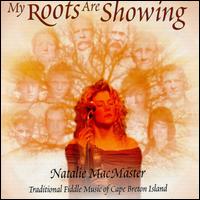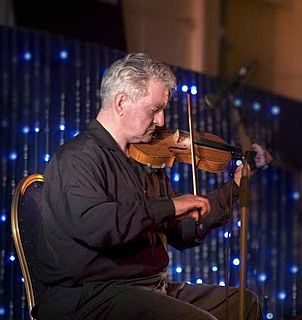
The Donegal fiddle tradition is the way of playing the fiddle that is traditional in County Donegal, Ireland. It is one of the distinct fiddle traditions within Irish traditional music.

Scottish country dance (SCD) is the distinctively Scottish form of country dance, itself a form of social dance involving groups of couples of dancers tracing progressive patterns. A dance consists of a sequence of figures. These dances are set to musical forms which come from the Gaelic tradition of Highland Scotland, as do the steps used in performing the dances. Traditionally a figure corresponds to an eight-bar phrase of music.

The hornpipe is any of several dance forms played and danced in Britain and Ireland and elsewhere from the 16th century until the present day. The earliest references to hornpipes are from England with Hugh Aston's Hornepype of 1522 and others referring to Lancashire hornpipes in 1609 and 1613.

A Fife and Drum Corps is a musical ensemble consisting of fifes and drums. In the United States of America, fife and drum corps specializing in colonial period impressions using fifes, rope tension snare drums, and (sometimes) rope tension bass drums are known as Ancient Fife and Drum Corps. Many of these ensembles originated from a type of military field music.

Cape Breton fiddling is a regional violin style which falls within the Celtic music idiom. Cape Breton Island's fiddle music was brought to North America by Scottish immigrants during the Highland Clearances. These Scottish immigrants were primarily from Gaelic-speaking regions in the Scottish Highlands and the Outer Hebrides. Although fiddling has changed considerably since this time in Scotland, it is widely held that the tradition of Scottish fiddle music has been better preserved in Cape Breton.

Highland dance or Highland dancing is a style of competitive dancing developed in the Scottish Highlands in the 19th and 20th centuries, in the context of competitions at public events such as the Highland games. It was created from the Gaelic folk dance repertoire, but formalised with the conventions of ballet', and has been subject to influences from outside the Highlands. Highland dancing is often performed with the accompaniment of Highland bagpipe music, and dancers wear specialised shoes called ghillies. It is now seen at nearly every modern-day Highland games event.

The Celtic fiddle is one of the most important instruments in the traditional repertoire of Celtic music. The fiddle itself is identical to the violin, however it is played differently in widely varying regional styles. In the era of sound recording some regional styles have been transmitted more widely while others have become more uncommon.
Scottish fiddling may be distinguished from other folk fiddling styles by its particular precision of execution and energy in the delivery, for example, the rendering of the dotted-quaver/semi-quaver rhythmic patterns, commonly used in the Strathspey. Christine Martin, in her Traditional Scottish Fiddling players guide, discusses the techniques of "hack bowing", "the Scottish Snap", and "snap bowing". These techniques contrast quite sharply with the most common bowing patterns of Irish fiddling. The style has a very large repertoire consisting of a great variation of rhythms and key signatures. There is also a strong link to the playing of traditional Scottish bagpipes which is better known throughout the world.
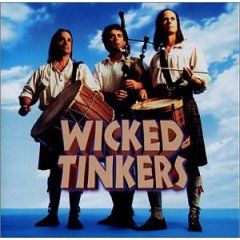
Wicked Tinkers is the debut album released by Wicked Tinkers.

Banger For Breakfast is the fourth album released by Wicked Tinkers.
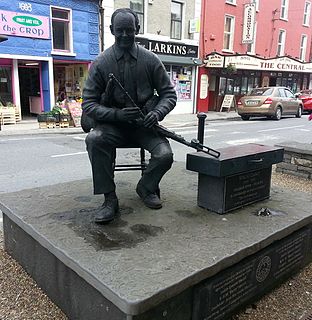
Willie Clancy was an Irish uilleann piper, flute player and whistle player.

Blueprint is an album by Natalie MacMaster, released in 2003 on the Rounder Records label.

Blackwater is the fifth studio album by Altan, released in April 1996 on the Virgin Records label. Three of the songs are sung in Irish. "Ar Bhruach Na Carraige Baine" is sung partly in English and in Irish. "Blackwaterside" is sung in English. It was the first album released by the band since the death of founding member Frankie Kennedy two years earlier. The final track on the album is a tribute to Kennedy and was written by Mairéad Ní Mhaonaigh herself.

Téada, an Irish band, plays traditional music. Téada is Irish for "strings". The five members of the band are fiddle player Oisín Mac Diarmada, button accordion player Paul Finn, Damien Stenson performs on flutes and various whistles, Seán Mc Elwain switches between the bouzouki and guitar and bodhrán player Tristan Rosenstock.
Johnny Doran was an Irish uilleann piper.
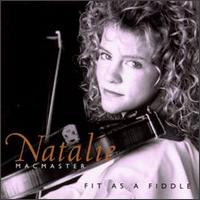
Fit as a Fiddle is an album by Natalie MacMaster. It was reissued by Rounder Records in 1997.
Donald Angus Beaton (1912–1981) was a Canadian blacksmith and a Cape Breton-style fiddler.
Archie Dagg was a shepherd and traditional fiddler, piper and composer from central Northumberland. He was born at Linbriggs, in Upper Coquetdale, and except for his time in the Army at the end of the First World War, lived all his life in that region. In the late 1930s, he was a member of the English Sheepdog Trials Team; when competing with them in Scotland, he would play Scottish tunes on the Northumbrian smallpipes, and found he would get a steady supply of free drams.
Beg & Borrow is the thirty-second album by Battlefield Band and their twenty-fourth studio album, released on the Temple Records label as a digital download on 21 August 2015 and on CD in the UK on 18 September 2015 and in the United States on 16 October 2015.
